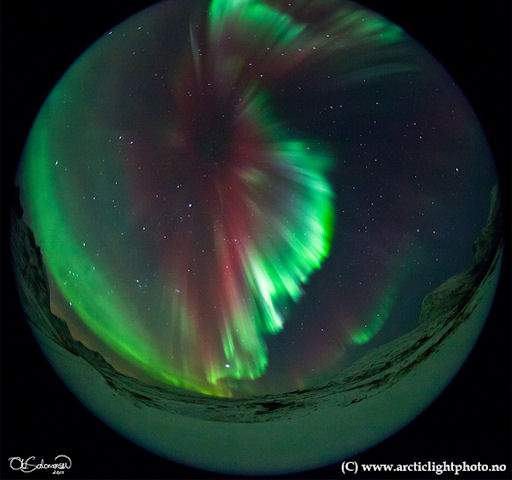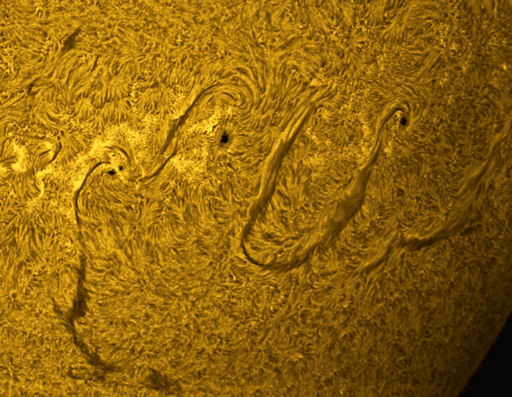Metallic photos of the sun by renowned photographer Greg Piepol bring together the best of art and science. Buy one or a whole set. They make a stellar gift. | | |
CME IMPACT: As predicted by analysts at the Goddard Space Weather Lab, a coronal mass ejection (CME) hit Earth's magnetic field at approximately 2145 UT on Nov. 28th. The impact was weaker than expected, but it still produced bright auroras around the Arctic Circle:

"I am really glad I decided to go out last night for the forecasted CME," says photographer Ole C. Salomonsen of Tromsø, Norway. "Mind-blowing auroras were all over the sky, and I was running like a madman between my two cameras to change composition throughout the night."
Aurora tour guide Chad Blakely watched the show from the Finnsh Lapland. "The auroras exploded all over the sky," he says. "Here is a time-lapse video of the event with a few hours compressed into less than a minute. If this is a sign of things to come the rest of the season should be fantastic!"
Some of the auroras reached all the way down to the contiguous United States, shown here in Wisconsin and Minnesota. Not bad for a "weak impact." Aurora alerts: text, phone.
more images: from Fredrik Broms of Kvaløya, Norway; from Antti Pietikäinen of Muonio, Lapland, Finland; from Zoltan Kenwell of Alberta, Canada; from Dirk S.Miller of Rice Lake, Wisconsin; from Warren Gammel of Big Lake, Minnesota; from Ulf Jonsson of Gussö, Luleå, Sweden; from Helge Mortensen of Kvaløya, Norway; from Hanneke Luijting of Tromsø, Norway; from B.Art Braafhart of Salla - Finnish Lapland; from Andy Keen of Ivalo Region, Finland, Scandinavia;
SINUOUS SUNSPOTS: A line of sunspots stretching across the sun's northern hemisphere appears to be an independent sequence of dark cores. A telescope tuned to the red glow of solar hydrogen, however, reveals something different. The sunspots are connected by sinuous filaments of magnetism:

"These sunspots writhe and squirm energetically as they rotate away from us!" says John Nassr, who took the picture on Nov. 28th from his backyard observatory in Baguio, the Philippines.
The connections suggest an interesting possibility. While each sunspot individually poses little threat for strong solar flares, an instability in one could start a chain reaction involving all, leading to a widespread eruption. Readers with solar telescopes are encouraged to monitor developments.
more images: from Leonard E. Mercer of Attard, Malta; from Ron Cottrell of Oro Valley, Arizona; from Jo Dahlmans of Ulestraten, The Netherlands; from Peter Desypris of Athens,Greece

